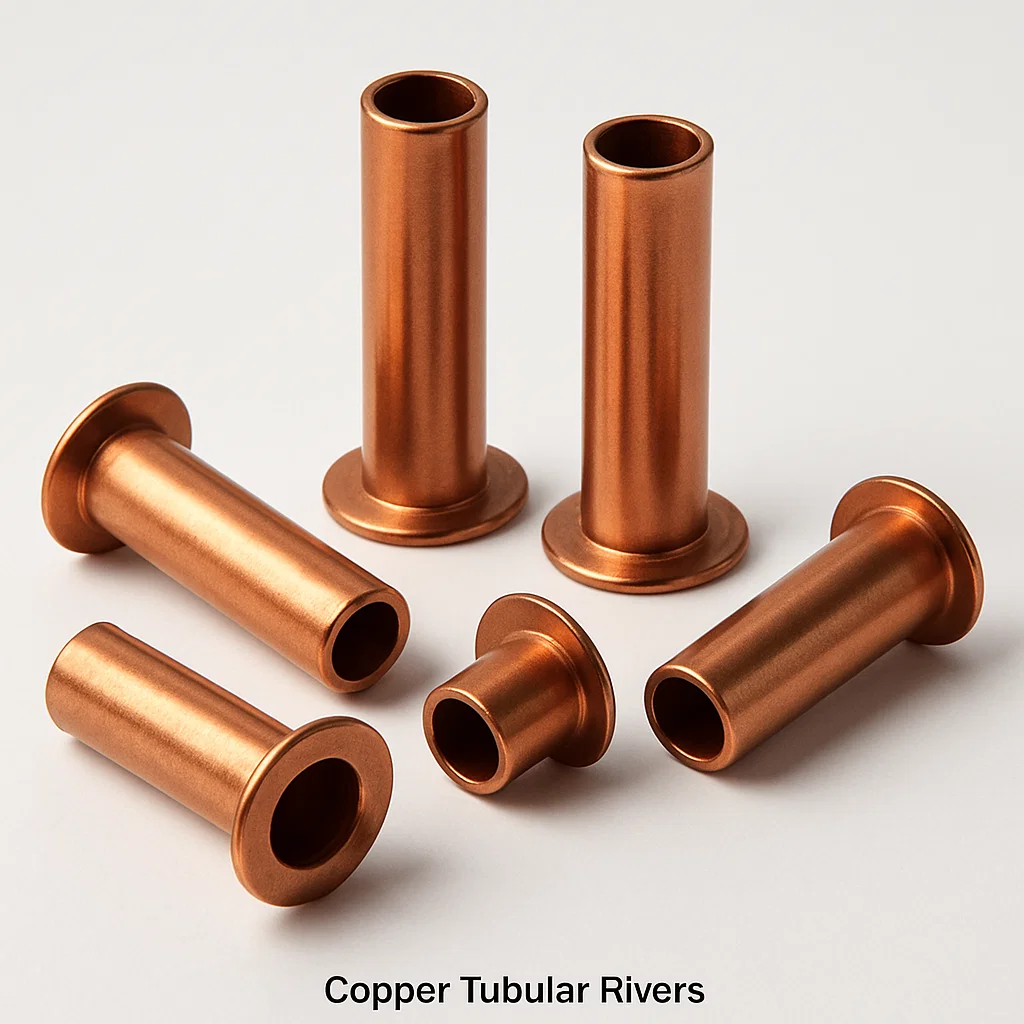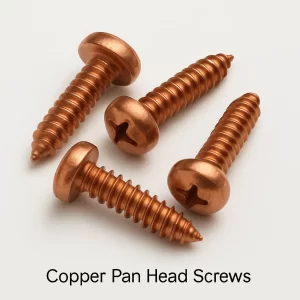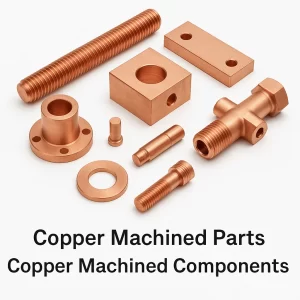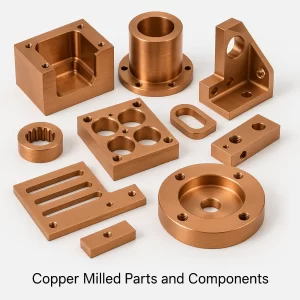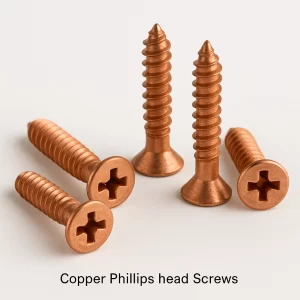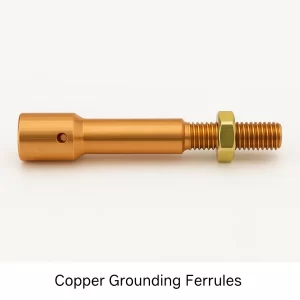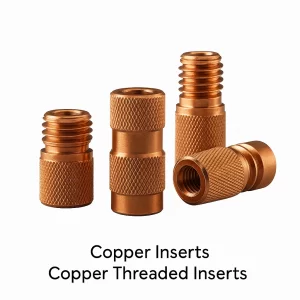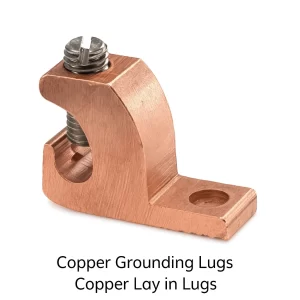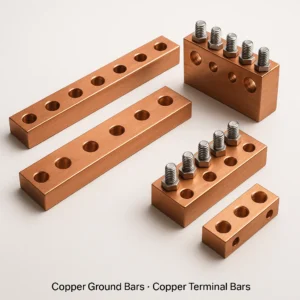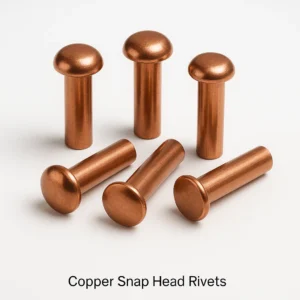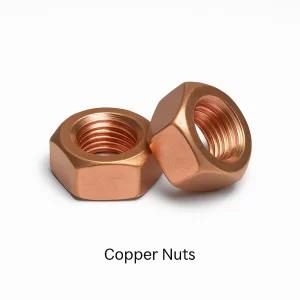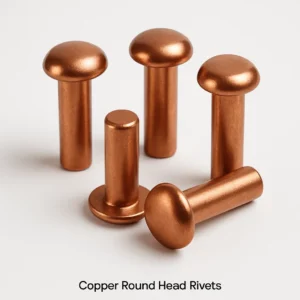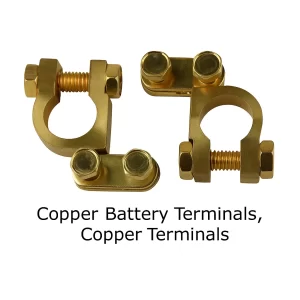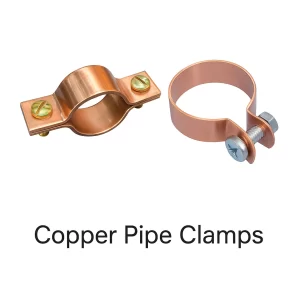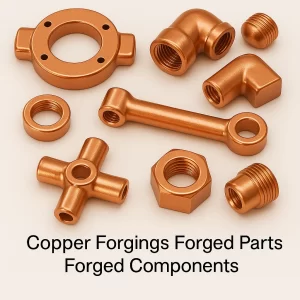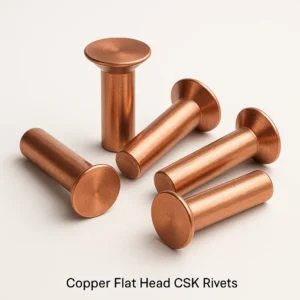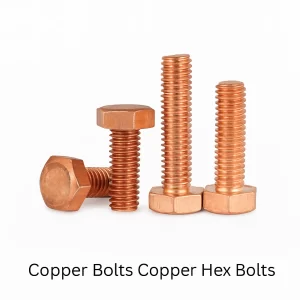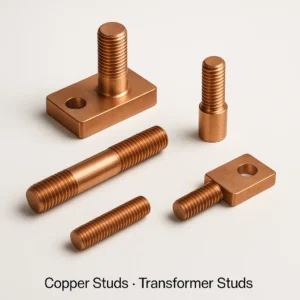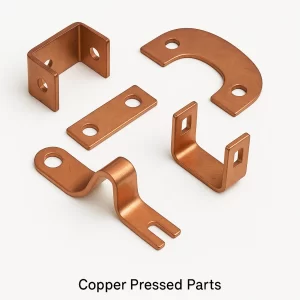Comprehensive Overview of Copper Tubular Rivets and Semi-Tubular Copper Rivets
We are one of the leading manufacturers and exporters of Copper Tubular Rivets and Semi-Tubular Copper Rivets from India. We have been supplying precision copper tubular rivets, copper semi-tubular rivets, copper hollow rivets, copper eyelet rivets, and specialty copper hollow fasteners to the world market for many decades. Our state-of-the-art manufacturing facility specializes in producing high-quality copper tubular rivets using advanced cold forming technology, precision tube drawing operations, automatic tubular rivet forming machines, CNC machining operations, surface finishing processes, and comprehensive quality testing. With over three decades of global experience in copper tubular rivet manufacturing, we serve diverse industries including copper tubular rivets for electrical assemblies and terminal connections, leather goods copper eyelets for bags and garments, copper tubular rivets for electronic circuit boards and connectors, decorative copper tubular rivets for furniture and upholstery, copper hollow rivets for automotive interior trim, copper eyelet rivets for canvas and textile products, copper tubular rivets for packaging and container assembly, copper semi-tubular rivets for appliance manufacturing, copper tubular rivets for footwear and belt assemblies, and copper hollow rivets for light-duty mechanical fastening applications. Our expertise encompasses working with various copper grades including pure Copper C11000 tubular rivets offering excellent formability and corrosion resistance, Copper C10200 oxygen-free tubular rivets for electrical applications, tin-plated copper tubular rivets for enhanced corrosion protection, nickel-plated copper tubular rivets for wear resistance, and brass tubular rivets for decorative applications. We manufacture copper tubular rivets ranging from miniature 1mm diameter eyelet rivets to large 12mm diameter hollow rivets with lengths from 2mm to 50mm, all maintaining precise hole dimensions, consistent wall thickness, accurate head geometry, excellent surface finish, and reliable performance in light-duty fastening, electrical terminal, decorative assembly, and material piercing applications.
Copper Tubular Rivets – Semi-Tubular and Hollow Copper Rivets
Copper Tubular Rivets represent specialized hollow fasteners with cylindrical holes extending partially (semi-tubular) or completely (full tubular) through the rivet shank, designed for permanent mechanical joining requiring lower installation forces than solid rivets, self-piercing capability in soft materials, electrical terminal connections, and decorative fastening applications. These copper tubular rivets are manufactured from copper tubing or through piercing solid wire, creating consistent hole depth, precise wall thickness, and uniform head geometry.
Copper tubular rivets find extensive applications in:
- Electrical and Electronics: PCB terminal rivets, wire harness eyelets, electrical contact rivets, battery terminal connections, transformer lead connections, motor terminal rivets, and ground wire eyelets
- Leather Goods and Apparel: Leather belt eyelets, handbag decoration rivets, shoe and boot eyelets, garment decoration rivets, leather strap reinforcement, wallet and purse rivets, and canvas bag grommets
- Automotive Interior: Dashboard trim rivets, door panel fasteners, headliner attachment, seat cover rivets, carpet fastening, interior fabric assemblies, and decorative trim rivets
- Furniture and Upholstery: Furniture fabric attachment, decorative upholstery rivets, chair assembly rivets, cabinet hardware, drawer pull rivets, and industrial furniture fastening
- Packaging and Containers: Cardboard box reinforcement eyelets, shipping container rivets, food packaging rivets, pharmaceutical packaging, cosmetic container assembly, and tamper-evident seals
- Textile and Canvas Products: Tent and awning grommets, tarp eyelets, banner reinforcement, sail grommets, canvas bag hardware, and industrial fabric assembly
- Footwear Manufacturing: Shoe eyelet rivets for laces, boot decoration rivets, sandal strap attachment, insole fastening, and decorative shoe hardware
- Appliance Manufacturing: Light-duty appliance assembly, control panel attachment, decorative trim rivets, nameplate fastening, and cover assembly rivets
Our copper tubular rivet manufacturing services include engineering consultation for rivet selection based on material thickness, installation method, hole piercing requirements, and load capacity, material recommendation including pure copper C11000 for standard applications with excellent formability, oxygen-free copper C10200 for electrical terminals, tin-plated copper for corrosion protection, and nickel-plated copper for wear resistance, custom rivet design for special head styles, hole depths, wall thickness specifications, and flange configurations, prototype development with dimensional verification and installation testing, production manufacturing using high-speed automatic tubular riveting machines, various configurations including semi-tubular rivets with partial hole depth (typically 60-80% of shank length), full tubular rivets with complete through-hole, countersunk head tubular rivets for flush installations, flat head tubular rivets, oval head tubular rivets, truss head tubular rivets, and eyelet rivets (full tubular with flanged heads on both ends), dimensional capabilities from miniature 1mm diameter eyelets for electronics to large 12mm diameter hollow rivets for industrial applications, lengths from 2mm to 50mm with hole depths ranging from 1mm to full length, tolerance specifications including diameter tolerance ±0.05mm, hole depth tolerance ±0.2mm, wall thickness consistency ±0.1mm, and head concentricity within 0.1mm, surface treatments including bright tin plating (3-10 microns), nickel plating (5-15 microns), brass plating for golden appearance, colored lacquers for decorative applications, and bare copper with protective coating, and complete documentation including material certificates, dimensional inspection reports, mechanical test results, and compliance certifications.
We accommodate copper tubular rivet production from small quantities for custom designs to high-volume production exceeding 5 million pieces monthly, with material specifications conforming to ASTM B75 (seamless copper tube), ASTM B152 (copper sheet and strip), DIN 7340 (tubular rivets), ISO 8748 (semi-tubular rivets), and JIS B1213 (tubular rivets). Lead time typically ranges from four to six weeks for custom designs, with 1-2 weeks for standard sizes from inventory.
Copper Material Grades and Tubular Rivet Specifications
Copper Material Specifications and Standards
| Copper Grade | Key Properties | Typical Applications | Standards |
|---|---|---|---|
| Copper C11000 | 99.9% pure copper, excellent formability, superior corrosion resistance | Standard tubular rivets, eyelets, decorative rivets | ASTM B75, B152, DIN 1787 |
| Copper C10200 | Oxygen-free copper, 101% IACS conductivity, premium electrical | Electrical terminal rivets, PCB connections | ASTM B170, B75 |
| Tin-Plated Copper | 3-10 micron tin coating, enhanced corrosion protection, bright finish | Outdoor applications, marine eyelets, packaging rivets | ASTM B545 |
| Nickel-Plated Copper | 5-15 micron nickel coating, wear resistance, attractive finish | Decorative applications, apparel hardware, harsh environments | ASTM B689 |
| Brass Plated Copper | Golden appearance, decorative finish | Fashion accessories, decorative furniture hardware | DIN 50966 |
Copper Tubular Rivet Mechanical Properties
| Property | Soft Copper Tubular | Work-Hardened Tubular | Tin-Plated | Nickel-Plated |
|---|---|---|---|---|
| Tensile Strength | 200-240 MPa | 260-310 MPa | 200-240 MPa | 220-260 MPa |
| Shear Strength | 120-150 MPa | 160-190 MPa | 120-150 MPa | 130-160 MPa |
| Hardness (Vickers) | 40-60 HV | 70-95 HV | 40-60 HV | 55-80 HV |
| Elongation | 40-50% | 10-25% | 35-45% | 30-40% |
| Installation Force | Low (40-60% of solid) | Medium (50-70% of solid) | Low | Low-Medium |
| Operating Temperature | -200 to +150°C | -200 to +150°C | -40 to +105°C | -40 to +180°C |
Standard Tubular Rivet Sizes and Configurations
Dimensional Standards for Copper Tubular Rivets
| Nominal Diameter | Head Diameter | Head Height | Hole Diameter | Hole Depth | Length Range | Applications |
|---|---|---|---|---|---|---|
| 1.0mm | 2.0-2.5mm | 0.4-0.6mm | 0.5-0.7mm | 0.6-1.5mm | 2-8mm | Electronics, miniature eyelets |
| 1.5mm | 2.8-3.2mm | 0.6-0.8mm | 0.8-1.0mm | 1.0-2.5mm | 3-10mm | PCB terminals, small eyelets |
| 2.0mm | 3.5-4.0mm | 0.8-1.2mm | 1.0-1.4mm | 1.5-4mm | 3-12mm | Leather eyelets, electrical terminals |
| 2.5mm | 4.2-4.8mm | 1.0-1.5mm | 1.4-1.8mm | 2.0-5mm | 4-15mm | Garment eyelets, light assembly |
| 3.0mm | 5.0-5.8mm | 1.2-1.8mm | 1.6-2.2mm | 2.5-6mm | 5-18mm | Belt eyelets, bag hardware, furniture |
| 4.0mm | 6.5-7.5mm | 1.5-2.3mm | 2.2-3.0mm | 3.0-8mm | 6-25mm | Automotive trim, heavy leather goods |
| 5.0mm | 8.0-9.5mm | 2.0-3.0mm | 2.8-3.8mm | 4.0-10mm | 8-30mm | Canvas grommets, furniture, packaging |
| 6.0mm | 9.5-11.5mm | 2.5-3.5mm | 3.5-4.8mm | 5.0-12mm | 10-35mm | Industrial assembly, heavy-duty eyelets |
| 8.0mm | 12.0-15.0mm | 3.0-4.5mm | 5.0-6.5mm | 6.0-16mm | 12-40mm | Large grommets, industrial fastening |
Tubular Rivet Types and Head Styles
Semi-Tubular Rivets: Partial hole depth (60-80% of shank length), stronger than full tubular, requires moderate installation force, suitable for thin to medium materials (0.5-3mm thickness), most common type for general applications.
Full Tubular (Hollow) Rivets: Complete through-hole, lowest installation force, excellent for self-piercing soft materials, ideal for very thin materials, used as eyelets and grommets.
Eyelet Rivets: Full tubular with flanged heads on both ends, installed through pre-punched hole, used for lacing, reinforcement, and decoration, common in leather goods and textiles.
Countersunk Head Tubular: Flush installation in countersunk holes, aerodynamic or smooth surface requirements, typical cone angles 90° or 120°.
Flat Head Tubular: Low-profile head, large bearing surface, suitable for soft materials, decorative applications.
Oval Head Tubular: Rounded head profile, aesthetic appearance, common in furniture and decorative applications.
Truss Head Tubular: Wide low-profile head, excellent bearing area, prevents pull-through in soft materials.
Manufacturing Process
Tube Preparation and Forming
Copper tube drawing operations producing precise outer diameter and wall thickness, or solid wire piercing creating tubular section, tube cutting to precise blank lengths with ±0.2mm tolerance, end facing operations ensuring square tube ends, and material cleaning removing drawing lubricants.
Cold Heading and Forming
Automatic tubular rivet machines forming heads through progressive dies, single or multiple blow operations depending on head size, heading speed 150-300 pieces per minute for standard sizes, tube end expansion forming head geometry, wall thickness control during heading operation, and minimal material waste compared to solid rivet machining.
Secondary Operations
Hole depth adjustment through drilling or punching if required, countersinking for flush-head varieties, deburring internal and external edges, thread forming for threaded tubular rivets, knurling for decorative or grip enhancement, and trimming operations for precise length control.
Heat Treatment and Surface Finishing
Stress relief annealing at 200-300°C for soft copper rivets, tumbling in ceramic media for smooth surface finish, electroplating operations including tin, nickel, or brass plating, colored lacquer coating for decorative applications, clear protective coating preventing tarnish, and drying and curing processes.
Quality Control
Dimensional inspection using optical comparators and micrometers, hole depth measurement with depth gauges, wall thickness verification using ultrasonic or mechanical methods, concentricity checks for head alignment, mechanical testing including installation force measurement and clinch testing, electrical testing for terminal applications, plating thickness measurement using XRF, and visual inspection for surface defects.
Installation Methods and Joint Design
Tubular Rivet Installation Techniques
Manual Setting: Hand-operated eyelet and grommet setting tools, anvil and punch method, suitable for 1-5mm diameter rivets, low production volumes, field installation and repairs, requires pre-punched holes for eyelets.
Pneumatic Setting: Air-powered rivet setting machines, controlled force and stroke, faster than manual operation, suitable for 2-8mm diameter rivets, production rates 300-1000 per hour, consistent quality with proper setup.
Automatic Feeding Machines: High-speed automatic tubular riveting systems, automatic rivet feeding and placement, production rates exceeding 3000 per hour, excellent for high-volume production, common in appliance and electronics manufacturing.
Self-Piercing Installation: Semi-tubular rivets piercing soft materials without pre-punched holes, sharp tube edge cuts material during installation, requires 40-60% less force than solid rivets, suitable for leather, plastics, composites, textiles, and layered materials up to 3mm combined thickness.
Orbital Forming: Rotating tool forms rolled-over clinch, cosmetically superior finish, low noise operation, suitable for decorative applications, produces consistent mushroom clinch.
Joint Design Considerations
Material Thickness: Semi-tubular rivets suitable for combined material thickness 0.5-5mm, full tubular rivets best for 0.3-3mm, hole depth must exceed material thickness by 1-2mm for proper clinch formation, insufficient depth causes weak joints.
Hole Size Requirements: Pre-punched holes for eyelets should be 0.1-0.2mm larger than rivet outside diameter, self-piercing rivets require no pre-punching in soft materials, countersunk holes for flush-head installation require precise angle matching.
Edge Distance: Minimum 2.5 times rivet diameter from edge to center prevents material tearing, increased to 3.5 times for brittle materials, critical in multiple rivet patterns.
Rivet Spacing: Minimum 3 times diameter between adjacent rivets, typical spacing 4-6 times diameter for load distribution, decorative patterns may use closer spacing with reduced load capacity.
Clinch Formation: Proper installation creates rolled-over edge on backside, clinch diameter should be 1.5-2.0 times rivet diameter, clinch height typically 0.5-1.0mm, insufficient clinch indicates inadequate hole depth or installation force.
Industries and Applications
Electrical and Electronics
PCB through-hole terminal rivets providing electrical connection and mechanical support, wire harness eyelets, battery terminal connections, transformer lead terminals, motor winding connections, and ground wire terminal eyelets.
Leather Goods and Fashion
Belt eyelets for buckle attachment, handbag decorative rivets and hardware, shoe and boot lacing eyelets, garment decoration and fastening, wallet and purse assembly, leather strap reinforcement, and fashion accessory hardware.
Automotive Manufacturing
Interior trim panel fastening, door panel and headliner attachment, seat cover and upholstery rivets, carpet fastening, decorative trim assemblies, and light-duty mechanical fastening applications.
Furniture and Upholstery
Furniture fabric and leather attachment, decorative upholstery rivets, chair and sofa assembly, cabinet hardware mounting, drawer pull attachment, and industrial furniture fastening.
Packaging Industry
Cardboard box reinforcement eyelets, shipping container assembly, food packaging applications, pharmaceutical packaging, cosmetic container assembly, and tamper-evident sealing.
Textile and Canvas Products
Tent and awning grommets for rope attachment, tarp eyelets, banner and signage reinforcement holes, sail grommets for marine applications, canvas bag hardware, and industrial fabric assembly.
Quality Standards and Testing
International Standards
- DIN 7340: German standard for tubular rivets, dimensional specifications
- ISO 8748: Semi-tubular rivets specifications, tolerances, and testing methods
- JIS B1213: Japanese industrial standard for tubular rivets
- ASTM B75: Seamless copper tube specifications for rivet manufacturing
- ASTM B152: Copper sheet, strip, plate, and rolled bar standards
- IEC 60512: Connectors for electronic equipment including eyelet terminals
Testing Procedures
Dimensional Testing: Optical comparator inspection, hole depth measurement, wall thickness verification, concentricity checks, and go-no-go gauging.
Mechanical Testing: Installation force measurement, clinch strength testing, pull-through testing, shear strength testing per ASTM F606, and joint performance evaluation.
Electrical Testing: Contact resistance measurement for terminal applications, conductivity verification, and current carrying capacity testing.
Corrosion Testing: Salt spray testing per ASTM B117 (96-500 hours depending on specification), humidity testing, and chemical resistance evaluation.
Plating Quality: XRF thickness measurement, adhesion testing per ASTM B571, uniformity inspection, and appearance evaluation.
Advantages of Tubular Rivets Over Solid Rivets
Lower Installation Force: Requires only 40-60% of force needed for solid rivets, reduces tool wear, enables lighter equipment, suitable for delicate materials, and reduces operator fatigue.
Self-Piercing Capability: Can pierce soft materials (leather, plastics, textiles) without pre-punched holes, eliminates drilling operation, faster assembly process, and lower total installation cost.
Material Economy: Lighter weight than solid rivets (30-50% less material), lower raw material cost, reduced shipping weight for bulk quantities, and environmental benefits from material reduction.
Consistent Performance: Controlled clinch formation, predictable installation behavior, uniform joint strength, and reduced quality variation compared to solid rivets in soft materials.
Aesthetic Options: Decorative head styles, various plating and color options, flush installation possibilities, and cleaner appearance with controlled clinch.
Versatility: Suitable for wider range of materials, effective in layered assemblies, accommodates material thickness variations, and works with delicate substrates that cannot withstand solid rivet installation forces.
Frequently Asked Questions
Q1: What is the difference between semi-tubular and full tubular rivets? Semi-tubular rivets have holes extending 60-80% through the shank, providing good strength while requiring less installation force than solid rivets. Full tubular (hollow) rivets have complete through-holes, require minimum installation force, are excellent for self-piercing, and are commonly used as eyelets. Semi-tubular offers better load capacity; full tubular offers easiest installation.
Q2: Can tubular rivets be used for structural applications? Tubular rivets are designed for light to medium-duty fastening (typically <500N shear load per rivet). For structural or high-load applications requiring >1000N per rivet, solid copper rivets are recommended. Tubular rivets excel in decorative, electrical terminal, and soft material assembly applications.
Q3: What materials can tubular rivets self-pierce? Semi-tubular copper rivets can self-pierce leather (up to 3mm), soft plastics, rubber, textiles, canvas, cardboard, and thin aluminum foil without pre-punched holes. Harder materials like steel, hard plastics, or thick aluminum require pre-punched holes. Combined material thickness should not exceed 3-4mm for reliable self-piercing.
Q4: How do I select between different surface finishes? Bare copper for indoor decorative applications where natural patina is acceptable. Tin-plated (3-10 microns) for outdoor use, corrosion protection, and bright appearance with 15-25% premium. Nickel-plated (5-15 microns) for fashion hardware, wear resistance, and attractive finish with 30-50% premium. Brass-plated for golden decorative appearance in fashion and furniture applications.
Q5: What is the typical lead time and minimum order quantity? Standard catalog sizes from inventory: 1-2 weeks, MOQ 5,000-10,000 pieces. Custom sizes and configurations: 4-6 weeks including tooling, production, surface treatment, and testing, MOQ 10,000-50,000 pieces depending on complexity. Prototypes and samples: 50-100 pieces available for evaluation within 1-2 weeks. Volume pricing available for quantities exceeding 100,000 pieces.
Why Choose Our Copper Tubular Rivet Services
- Three Decades of Manufacturing Excellence: 30+ years producing copper tubular rivets for electrical, leather goods, automotive, furniture, and packaging applications worldwide
- Advanced Tubular Forming Technology: High-speed automatic machines, precision tube drawing, controlled wall thickness, and consistent hole depth manufacturing
- Comprehensive Size Range: Miniature 1mm eyelets for electronics to large 12mm industrial rivets, lengths from 2mm to 50mm, custom configurations available
- Multiple Surface Finishing Options: Tin plating, nickel plating, brass plating, colored lacquers, and protective coatings with controlled quality
- Quality Certification: ISO 9001:2015 certified, compliance with DIN, ISO, JIS, ASTM standards, complete material traceability and documentation
- Competitive Pricing: India manufacturing providing 30-40% cost savings versus North American or European manufacturers while maintaining international quality standards
- Custom Engineering Support: Design assistance for special configurations, prototype development, installation guidance, and application-specific solutions
- High-Volume Production Capacity: Capability exceeding 5 million pieces monthly, automated production lines, consistent quality across large batches
- Global Export Experience: Serving customers across North America, Europe, Middle East, Asia-Pacific with established logistics and export documentation expertise
Contact Us Today
Ready to discuss your copper tubular rivet requirements? Our experienced team is here to help with your electrical terminal, leather goods, automotive, furniture, and packaging applications.
Request a Quote: Send specifications including diameter, length, hole depth, head style, surface finish, and quantity to sales@jambrass.com for detailed quotation within 24 hours.
Call Us: +91-22-43449300 / +91-22-43449323 (Monday-Saturday, 9:00 AM – 6:00 PM IST)
Office Address: 1406, 14th Floor, Dalamal Tower, Nariman Point, Mumbai – 400021, Maharashtra, India
Factory Address: Plot 10B, GIDC Industrial Estate, Shanker Tekari, Udyognagar, Jamnagar, Gujarat, India – 361004
Contact Person: Mr. Mehul Vora
Email: sales@jambrass.com

